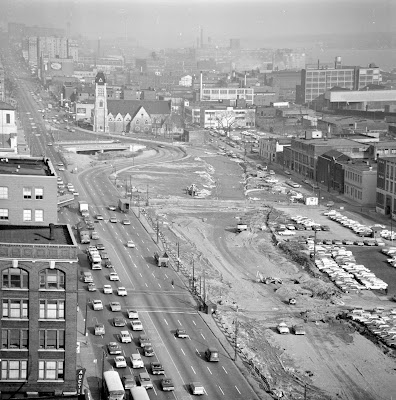 |
| Interstate 375 in Michigan will be a thing of the past. |
Ranked one of the shortest and most pointless interstate freeways in United States, Interstate 375 in Detroit was regarded as a relic of racism.
Now the Michigan Department of Transportation, city of Detroit and U.S. Department of Transportation have reached a deal to decommission and remove Interstate 375 from the roster. They will also convert the 1.06 mile freeway into a historical boulevard which will be a connection to neighborhoods that were impacted by the highway being built.
It was built in 1964 as a lower tier freeway for easy access to the Detroit-Windsor Tunnel.
On average the spur generates 15,000 to 70,000 vehicles a day. That includes travel to downtown, Comerica Park, Hollywood Casino Greektown, Fox Theatre, Ford Stadium and Little Caesars Arena and MGM Grand.
Construction on the first segments of the Chrysler Freeway started on January 30, 1959. The area where the freeway was built was called Black Bottom, a historic district that received its name from the soil found there by French explorers. In the 1940s and 1950s, the area was home to a community of African-American entrepreneurs and businesses that rivaled Harlem in New York City. Black Bottom was one of the oldest neighborhoods in the city, and, at the time of freeway construction, it had wooden sewers and dilapidated buildings. In the 1950s and 1960s, many lower-class African-American residents lived in overcrowded and run-down housing in Black Bottom. These residents could not afford to maintain their homes because of their low income, leading outsiders to view the area as neglected and in need of updating and development. The area, like Corktown to the west of downtown, was targeted by urban planners for urban renewal and infrastructure improvements in the 1950s and 1960s, which included the Chrysler Freeway and public housing projects. In the case of the construction of the Chrysler Freeway, some of the most crucial entertainment and cultural communities in Detroit, Black Bottom, and Paradise Valley were destroyed.
On June 12, 1964, a surface street highway/freeway in Detroit that ran north from Jefferson Avenue and Randolph Street to the Fisher/Chrysler freeway interchange was opened. The southernmost segment, built through the Black Bottom neighborhood, was designated I-375 at this time. The freeway cost $50 million to build (equivalent to $325 million in 2020).
 |
| Building Interstate 375 through predominantly Black neighborhoods. |
The U.S. Department of Transportation awarded Michigan $104.6 million to dismantle the 1-mile interstate, part of $1.5 billion in grants awarded by the department nationwide. The program, Reconnecting Communities, was part of the bipartisan infrastructure package passed earlier this year.
The funding will enable Michigan to move forward with its $270 million plan to turn the highway into a street-level boulevard, reconnecting historic neighborhoods. After years of planning dating back to 2013, the highway removal is now estimated to begin as soon as 2025, two years earlier than expected, with construction finished by 2028.
The project includes removing 15 old bridges, adding LED lighting, building wider sidewalks, bike lanes and pedestrian crossings, and more.
“This stretch of I-375 cuts like a gash through the neighborhood, one of many examples I have seen in communities across the country where a piece of infrastructure has become a barrier,” Transportation Secretary Pete Buttigieg told The Associated Press. “With these funds, we’re now partnering with the state and the community to transform it into a road that will connect rather than divide,” Buttigieg said.
Michigan Gov. Gretchen Whitmer requested the federal funding last year. In a letter to U.S. Transportation Secretary Pete Buttigieg, Whitmer said the stretch of freeway in Detroit was a “perfect candidate” for the program, given that the road leveled and dislocated several communities of color when it was constructed in the early 1960s.
Black Bottom and Paradise Valley, two of the city’s predominantly African American neighborhoods, were razed as part of the 1950s creation of an interstate highway system, displacing 100,000 Black residents and erecting a decades-long barrier between the downtown and communities to the east.
“I-375 was built due to the 1956 Federal Interstate Highway Act. Many of these interstate highways would destroy, disrupt and wipe out African American business districts and African American residential communities,” said historian Jamon Jordan.
No comments:
Post a Comment